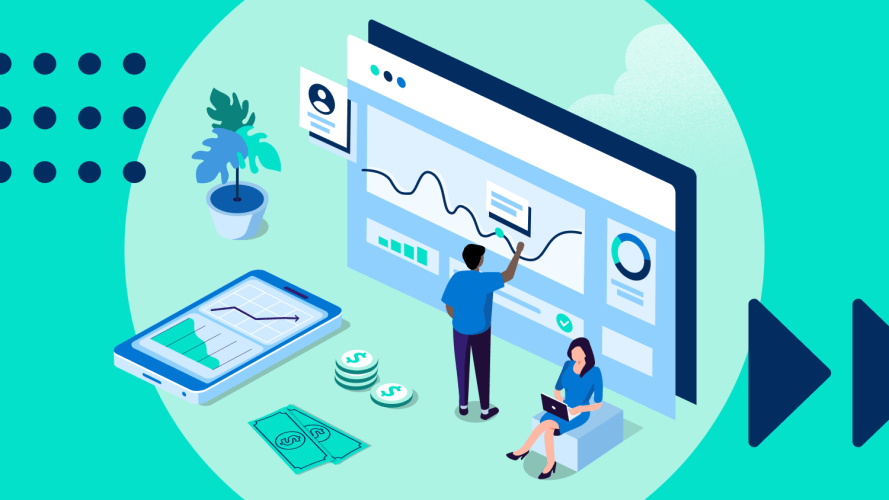3 Ways Generative AI Will Help Marketers Connect With Customers
3 min read


Imagine a world where you create a new product that everyone wants. It’s a snap to make and it sells itself – a mega hit. Congratulations, you’ve smashed your goals!
In this world, there is no overnight success. If you sell a product without attracting the right buyers and demonstrating how it meets their needs, it may just sit on the shelf. Meanwhile, a competitor does their research, knows what buyers want, and delivers it. Not only have you lost revenue, you’ve lost potential customers to the competition. Ouch.
How do you avoid this and capture customer interest? Build a comprehensive go-to-market (GTM) strategy that combines careful research with tailored messaging that hits on the right buyer pain points.
What is a go-to-market strategy?
Why is a go-to-market strategy important?
How to build a go-to-market strategy framework
Go-to-market strategy example
A go-to-market strategy is a step-by-step plan for introducing a new product to buyers. This includes market, customer, and competitive research that uncovers problems your product can solve. Creating a buyer persona lets you target prospects with key messaging that emphasizes your product’s unique problem-solving value.
Learn how Sales Cloud can help you score your best leads and prioritize them by how likely they are to close.



A well-crafted GTM strategy ensures target buyers see your product, understand and appreciate its value, and are compelled to buy. As Howard Brown, CEO of Revenue.io put it, “Meeting expectations early and often builds trust and is the foundation of any successful partnership.”
You can launch a product without a go-to-market strategy, but buyers who really need your product might not see or appreciate its value. They might turn to competitors who are already established in the marketplace and are percieved to be stable. In the early stage, it’s normal for someone to see your solution and say, “Oh, you’re just like [competitor],” even if they don’t offer what you offer. Research bears this out, especially for smaller companies. Of startups that fail, more than a third do so because there was no identified market need.
A successful go-to-market strategy requires understanding your market, prioritizing buyers’ pains, and identifying your competitive advantage. Building a framework around these four elements can help deliver your product in a way that makes it “ready to buy.” Let’s run through how to do that in six steps.
Selling is about delivering value to your target buyer, and that often takes the form of a solution to a unique problem. To make sure you’re targeting the right problem, build out a buyer persona that connects their pain points to your solution.
To surface this detail, you’ll start with your existing customers. Dig into customer data in your CRM, conduct interviews with buyers whose problems you’ve solved, and lead market research efforts to see where else these needs surface in your industry. (Check out our comprehensive guide on buyer personas for more guidance.)
If you sell B2B, your team will likely be coordinating a purchase with multiple people at each prospective company. The buying group might include end users, the CFO, an operations lead, and so on. Make sure you include problems and needs for these roles in your buyer persona.
Going to market with a new product isn’t just about making sure you solve prospects’ problems. It’s also about separating yourself from the crowd of products already in market. To make sure you’re delivering unique value, conduct research on competitors with similar products to see how they’re positioned. Use these questions to guide you:
If you have an AI-powered CRM, you can likely offload some of this research. Use AI tools to scan sales call transcripts for competitor mentions and pricing information. Pair this with automated online research based on industry, competitor, and product keywords. (Here’s how Sales Cloud does this.)
You know your target buyer’s problems. You know what competitors are doing to solve those problems. And, you know what your product offers. It’s time to connect all three and deliver a high-value solution that’s unique in your market. Build out a simple matrix so you can see all three and how they connect. Here’s what this might look like:
Product: Long-lasting, high-performance running shoes with extra arch support priced 20% below similar products
Example buyer: Casual runner, mid-40s, median income
| Buyer problem | Your product solution | [Competitor] solution |
| Ex. Common running injuries make it hard to find well-fitting, supportive running shoes without getting something custom-made | Ex. Running shoes with extra arch and ankle support in most US and EU sizes | Ex. Running shoes with arch support, but no ankle support. Only available in the US. |
| Ex. High-quality running shoes with needed support are too expensive ($100+) | Ex. All running shoes in product line are $80 or less | Ex. Some running shoes are <$80, but don’t offer extra support or longevity |
To keep the focus on the buyer during this value mapping, review your matrix and ask: “How would my target buyer see or understand this?” That’s a good gut check before you frame your messaging.
Using your matrix from the previous step, draft messaging for each prospect problem that shows why your product is uniquely qualified to serve as a solution with proof points to back it up.
Let’s continue with the example of our shoe buyer. You know from your research that they are between the ages of 40 and 50, like to run as a hobby, and want to stay active despite minor injuries. But, they’re also price-conscious. Here’s what key messaging might look like for this target buyer:
Complete this messaging for every problem you’ve identified, making sure to demonstrate clear and measurable ROI. You can also emphasize the potential downsides to sticking with the status quo or going with the competition.
Now you need to reach your prospective customers. But how do you take your key messaging and combine it with the right buying channel? Start by identifying the channels your buyers typically use to make a purchase, then select the right strategy to match. Here are the most common strategies:

3 min read

6 min read
With the core elements of your go-to-market strategy in place, it’s time to get your product to the right buyers. As you ramp up marketing and sales on your channel(s) of choice, start tracking total units sold, prospect engagement and objections, and sales cycle length. You can do this easily with an AI-powered sales analytics tool that delivers insights in real-time.
If you lag behind expectations, consider adjusting elements of your go-to-market strategy to compensate. Go through the steps above again periodically (at least once a quarter) to make sure your research and persona are up-to-date. By surfacing any new needs or problems of your target buyers, you can adjust messaging to keep customers interested.
Mary, a software as a service (SaaS) company founder, is working on launching her new product to the market. Mary has created an innovative solution that automates data entry for companies with high volumes of customer information to manage. Her soft launch was a success, and she’s ready to sell.
To make sure she’s bringing in the right prospects, Mary develops a buyer persona based on conversations with her current customers, and conducting market research. After a few weeks, she lands on the target buyer: mid-sized retailers that take a lot of customer orders online and by phone. The problem: the only other software providers on the market are too expensive for mid-sized companies, and their solutions take too long to get up and running.
With this as a guide, Mary decides on key messaging:
Mary also knows from customer conversations that she needs a sales team to engage with prospects – it’s a long-term investment for her customers, so they need to see demos before they commit. So, she hires 10 sales reps to start conducting outreach and connecting with prospective customers.
Within a few weeks, the team has scheduled demos and is having in-person meetings. She even lands some initial clients, who find the software easy to set up out of the box and affordable for their budgets. Most of them are impressed with how it works, but there’s a problem: people say they need more app integrations to make data management easier.
That’s excellent feedback, so Mary takes it to her team. After some investigation, they land on the top 10 most requested apps to start. As customers start using Mary’s software with the app integrations, they see real time savings for their teams. Because they don’t have to spend extra time entering customer data manually, they can also save on headcount and ensure customer orders are shipped promptly. Within a few months, Mary saw a 40% increase in sales, with many customers saying they’ll write positive product reviews and refer their friends.
A go-to-market strategy may seem like more fuss than it’s worth, but it helps you accomplish the most important task in sales: solving customer problems. Just keep in mind that it’s not a “one and done” effort. Continually monitor your sales and customer engagement to see how you can adapt your strategy to meet evolving buyer needs.
Use Enablement from Sales Cloud to help reps identify target prospect’s key problems, then deliver solutions that make it easy to buy.




Get the latest articles in your inbox.